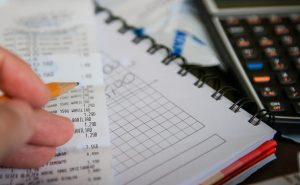 For many people tracking your spending is a new thing. It’s the beginning step to creating your spending plan. You need to know where your money has gone in order to make changes and get it going where you want it to go.
For many people tracking your spending is a new thing. It’s the beginning step to creating your spending plan. You need to know where your money has gone in order to make changes and get it going where you want it to go.
There is no one best way to track your spending. The method you use is entirely up to you. The first step is to think back to your last paycheck. Try to remember exactly where you spent your money. You will find that it’s nearly impossible to account for every dollar, after it is spent. Tracking money while you are spending is more accurate and complete.
Common Methods for Tracking Spending
Notebook or ledger
Some people find that carrying a small notepad with a pen or pencil is the best option for them. Every time they spend money—regardless of whether they’re in a store, at a vending machine, or out with friends—they immediately write down the amount. On the other hand, they may write down their spending at the end of the day in a ledger.
You can use your phone instead of a piece of paper. Use the notepad feature or an app and record every purchase as you make it.
Collect receipts
Keep all your receipts and categorize them once a day or week, whatever works for you. You can store receipts in an envelope, shoebox, or even clipped to the refrigerator. You may need to jot down costs for items you don’t receive a receipt for such as vending machine items.
Review account statement
Looking at bank, debit card and/or credit card statements can help with tracking expenses. Keep in mind that if you shop at a large store, you may need your receipt to know if you bought food or clothing or school supplies, or something else.
Envelope method
 This is a tried-and-true method used for generations! Put your money (cash) into an envelope labeled for a specific purpose, like “groceries.” All grocery purchases are made from cash in that envelope—when the money is gone, spending in this category is done until the next paycheck. Put receipts for items purchased back in these envelopes to look more closely at details of purchases. For example, you might discover a large part of your grocery store spending is on personal care items and not food. (This is a really a combination of tracking expenses and managing spending.)
This is a tried-and-true method used for generations! Put your money (cash) into an envelope labeled for a specific purpose, like “groceries.” All grocery purchases are made from cash in that envelope—when the money is gone, spending in this category is done until the next paycheck. Put receipts for items purchased back in these envelopes to look more closely at details of purchases. For example, you might discover a large part of your grocery store spending is on personal care items and not food. (This is a really a combination of tracking expenses and managing spending.)
Some people don’t want to carry cash. In this case, they may prefer to label envelopes by spending categories and to put their receipts into the envelopes. Then, they can subtract the receipt amount from the amount they had planned to spend.
Spreadsheet or computer financial software
Computer programs like spreadsheets or personal finance software packages are good for tracking expenses and helping to develop and follow spending plans. The initial cost to purchase this type of software can be relatively high.
- Online tools: Some financial institutions offer free tracking and budgeting programs to their customers.
- Mobile apps: There are many different apps to use on different phones and tablets. Some are free and some have a minimal cost. Explore different apps and determine what works best for your situation. Consider what you will use consistently. Some apps work like the envelope method but it’s all electronic rather than cash.
Tips for Success:
- Whatever method you choose to track your spending, use it consistently.
- If you have multiple spenders in your family, you may have multiple tracking methods.
- If all members of your household prefer to use the same method, accounting for expenses will be easier.
In my family, my husband uses the notebook & receipt method. He jots down what he spends in a little spiral notebook he carries with him, but if he’s in a hurry he gets a receipt and puts it in the notebook. At the end of the day, his spending is recorded on a spreadsheet where I keep a master list of expenses. When my daughter was young, she used envelopes for activities, like going to the movies, skating, etc. If she wanted to do something that cost money, she could look in her envelops to see if she had enough money.
 Check out https://www.facebook.com/moneysmartcolorado for Colorado State University Extension Agents bringing financial education, programs and discussions to Coloradoans everywhere. For more information on personal finances check out Colorado State University Extension’s publications at https://extension.colostate.edu/topic-areas/family-home-consumer/.
Check out https://www.facebook.com/moneysmartcolorado for Colorado State University Extension Agents bringing financial education, programs and discussions to Coloradoans everywhere. For more information on personal finances check out Colorado State University Extension’s publications at https://extension.colostate.edu/topic-areas/family-home-consumer/.

